Legal and Ethical Responsibilities for Community Service Providers
VerifiedAdded on 2019/09/25
|11
|4218
|322
Report
AI Summary
This report comprehensively examines the legal and ethical responsibilities of community service providers and their staff in Australia. It outlines key legislations like the Associations Incorporations Act, Food Act, and Children and Young People Act, emphasizing the importance of adhering to ethical standards and documented policies, procedures, and protocols. The report explores the role of childcare professionals in child protection, wellbeing, and employment, including how to identify and mitigate vulnerabilities. It further addresses the need for breach control processes, ethical practices, and the management of conflicts of interest. The document highlights systems to uphold client rights, promote cultural, linguistic, and religious diversity, and improve policies and procedures. It also covers how to contribute to workplace improvements, ensuring continuous compliance with legal and ethical responsibilities, and the actions to be taken if client rights are not upheld. The report references key publications and emphasizes the National Quality Framework (NQF) in Australia, highlighting the implications of non-compliance and the importance of feedback and continuous review for policy improvement.
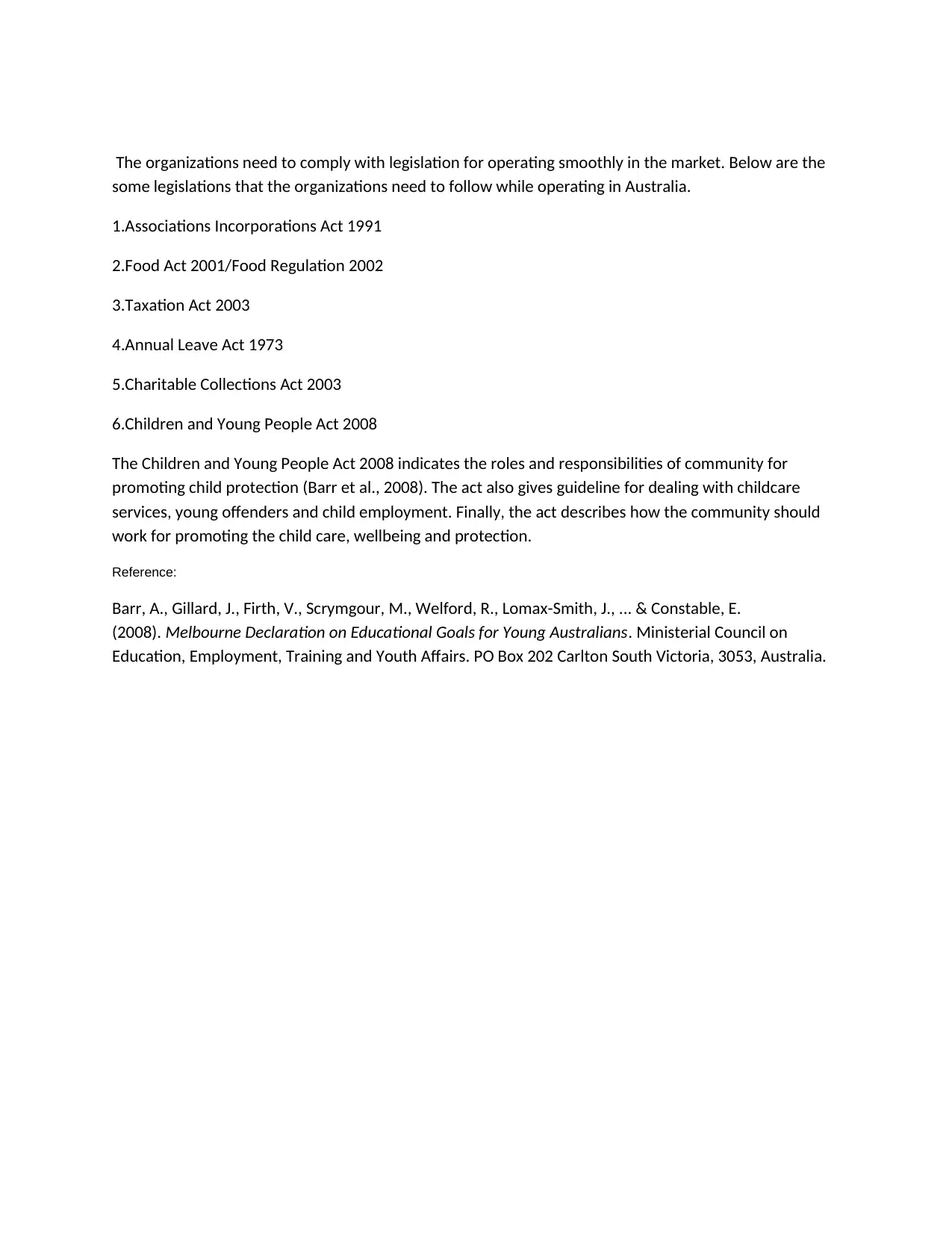
The organizations need to comply with legislation for operating smoothly in the market. Below are the
some legislations that the organizations need to follow while operating in Australia.
1.Associations Incorporations Act 1991
2.Food Act 2001/Food Regulation 2002
3.Taxation Act 2003
4.Annual Leave Act 1973
5.Charitable Collections Act 2003
6.Children and Young People Act 2008
The Children and Young People Act 2008 indicates the roles and responsibilities of community for
promoting child protection (Barr et al., 2008). The act also gives guideline for dealing with childcare
services, young offenders and child employment. Finally, the act describes how the community should
work for promoting the child care, wellbeing and protection.
Reference:
Barr, A., Gillard, J., Firth, V., Scrymgour, M., Welford, R., Lomax-Smith, J., ... & Constable, E.
(2008). Melbourne Declaration on Educational Goals for Young Australians. Ministerial Council on
Education, Employment, Training and Youth Affairs. PO Box 202 Carlton South Victoria, 3053, Australia.
some legislations that the organizations need to follow while operating in Australia.
1.Associations Incorporations Act 1991
2.Food Act 2001/Food Regulation 2002
3.Taxation Act 2003
4.Annual Leave Act 1973
5.Charitable Collections Act 2003
6.Children and Young People Act 2008
The Children and Young People Act 2008 indicates the roles and responsibilities of community for
promoting child protection (Barr et al., 2008). The act also gives guideline for dealing with childcare
services, young offenders and child employment. Finally, the act describes how the community should
work for promoting the child care, wellbeing and protection.
Reference:
Barr, A., Gillard, J., Firth, V., Scrymgour, M., Welford, R., Lomax-Smith, J., ... & Constable, E.
(2008). Melbourne Declaration on Educational Goals for Young Australians. Ministerial Council on
Education, Employment, Training and Youth Affairs. PO Box 202 Carlton South Victoria, 3053, Australia.
Paraphrase This Document
Need a fresh take? Get an instant paraphrase of this document with our AI Paraphraser
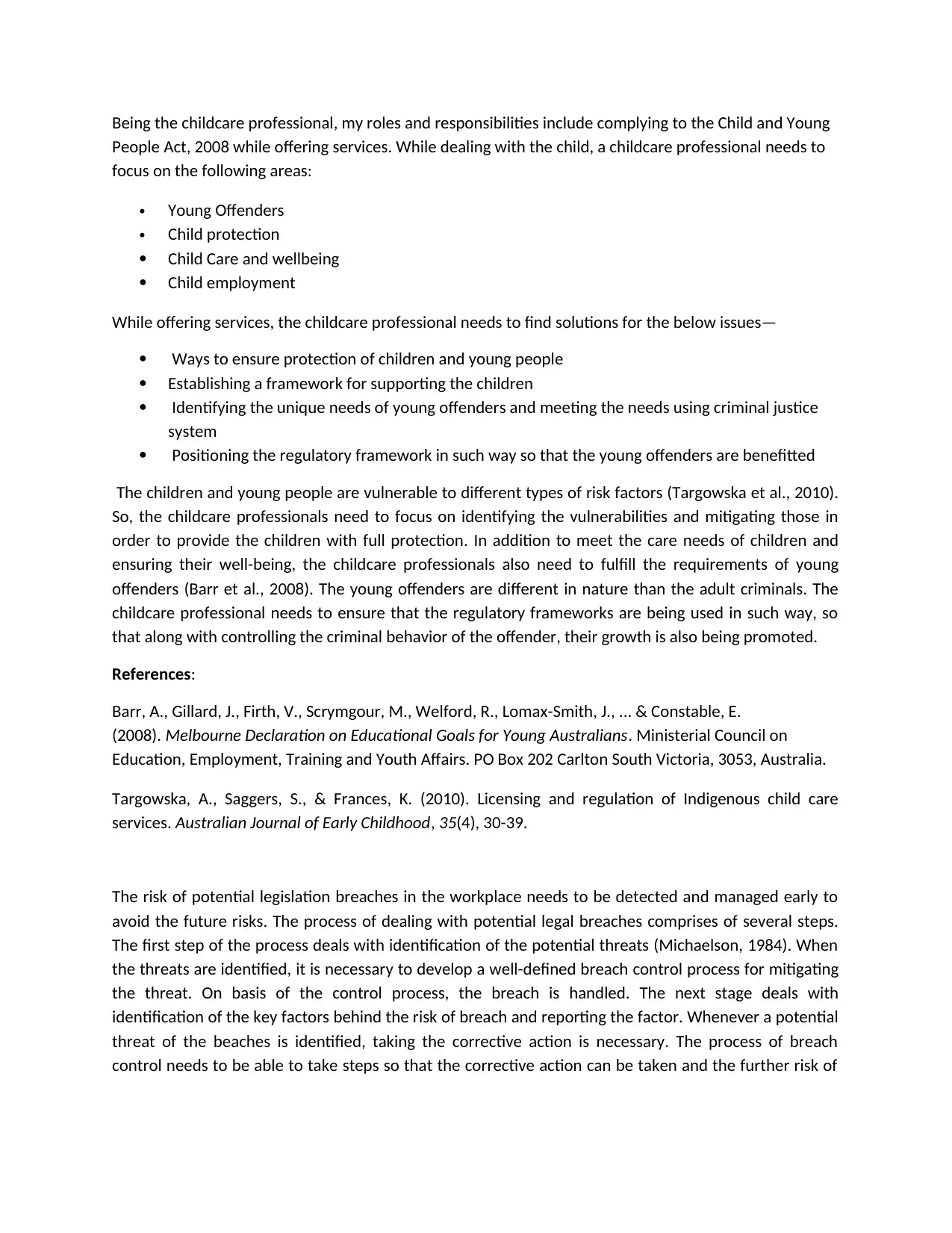
Being the childcare professional, my roles and responsibilities include complying to the Child and Young
People Act, 2008 while offering services. While dealing with the child, a childcare professional needs to
focus on the following areas:
Young Offenders
Child protection
Child Care and wellbeing
Child employment
While offering services, the childcare professional needs to find solutions for the below issues—
Ways to ensure protection of children and young people
Establishing a framework for supporting the children
Identifying the unique needs of young offenders and meeting the needs using criminal justice
system
Positioning the regulatory framework in such way so that the young offenders are benefitted
The children and young people are vulnerable to different types of risk factors (Targowska et al., 2010).
So, the childcare professionals need to focus on identifying the vulnerabilities and mitigating those in
order to provide the children with full protection. In addition to meet the care needs of children and
ensuring their well-being, the childcare professionals also need to fulfill the requirements of young
offenders (Barr et al., 2008). The young offenders are different in nature than the adult criminals. The
childcare professional needs to ensure that the regulatory frameworks are being used in such way, so
that along with controlling the criminal behavior of the offender, their growth is also being promoted.
References:
Barr, A., Gillard, J., Firth, V., Scrymgour, M., Welford, R., Lomax-Smith, J., ... & Constable, E.
(2008). Melbourne Declaration on Educational Goals for Young Australians. Ministerial Council on
Education, Employment, Training and Youth Affairs. PO Box 202 Carlton South Victoria, 3053, Australia.
Targowska, A., Saggers, S., & Frances, K. (2010). Licensing and regulation of Indigenous child care
services. Australian Journal of Early Childhood, 35(4), 30-39.
The risk of potential legislation breaches in the workplace needs to be detected and managed early to
avoid the future risks. The process of dealing with potential legal breaches comprises of several steps.
The first step of the process deals with identification of the potential threats (Michaelson, 1984). When
the threats are identified, it is necessary to develop a well-defined breach control process for mitigating
the threat. On basis of the control process, the breach is handled. The next stage deals with
identification of the key factors behind the risk of breach and reporting the factor. Whenever a potential
threat of the beaches is identified, taking the corrective action is necessary. The process of breach
control needs to be able to take steps so that the corrective action can be taken and the further risk of
People Act, 2008 while offering services. While dealing with the child, a childcare professional needs to
focus on the following areas:
Young Offenders
Child protection
Child Care and wellbeing
Child employment
While offering services, the childcare professional needs to find solutions for the below issues—
Ways to ensure protection of children and young people
Establishing a framework for supporting the children
Identifying the unique needs of young offenders and meeting the needs using criminal justice
system
Positioning the regulatory framework in such way so that the young offenders are benefitted
The children and young people are vulnerable to different types of risk factors (Targowska et al., 2010).
So, the childcare professionals need to focus on identifying the vulnerabilities and mitigating those in
order to provide the children with full protection. In addition to meet the care needs of children and
ensuring their well-being, the childcare professionals also need to fulfill the requirements of young
offenders (Barr et al., 2008). The young offenders are different in nature than the adult criminals. The
childcare professional needs to ensure that the regulatory frameworks are being used in such way, so
that along with controlling the criminal behavior of the offender, their growth is also being promoted.
References:
Barr, A., Gillard, J., Firth, V., Scrymgour, M., Welford, R., Lomax-Smith, J., ... & Constable, E.
(2008). Melbourne Declaration on Educational Goals for Young Australians. Ministerial Council on
Education, Employment, Training and Youth Affairs. PO Box 202 Carlton South Victoria, 3053, Australia.
Targowska, A., Saggers, S., & Frances, K. (2010). Licensing and regulation of Indigenous child care
services. Australian Journal of Early Childhood, 35(4), 30-39.
The risk of potential legislation breaches in the workplace needs to be detected and managed early to
avoid the future risks. The process of dealing with potential legal breaches comprises of several steps.
The first step of the process deals with identification of the potential threats (Michaelson, 1984). When
the threats are identified, it is necessary to develop a well-defined breach control process for mitigating
the threat. On basis of the control process, the breach is handled. The next stage deals with
identification of the key factors behind the risk of breach and reporting the factor. Whenever a potential
threat of the beaches is identified, taking the corrective action is necessary. The process of breach
control needs to be able to take steps so that the corrective action can be taken and the further risk of
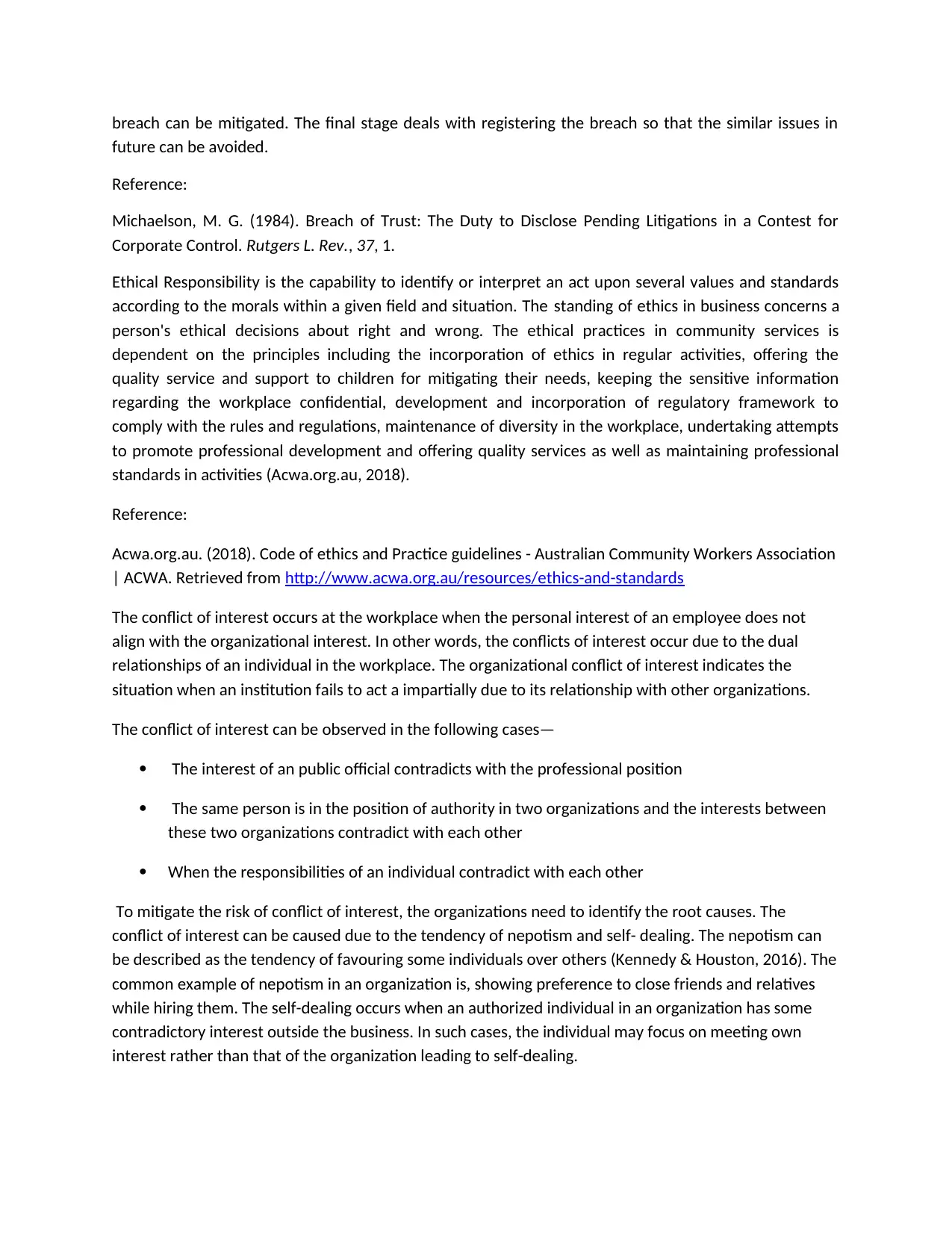
breach can be mitigated. The final stage deals with registering the breach so that the similar issues in
future can be avoided.
Reference:
Michaelson, M. G. (1984). Breach of Trust: The Duty to Disclose Pending Litigations in a Contest for
Corporate Control. Rutgers L. Rev., 37, 1.
Ethical Responsibility is the capability to identify or interpret an act upon several values and standards
according to the morals within a given field and situation. The standing of ethics in business concerns a
person's ethical decisions about right and wrong. The ethical practices in community services is
dependent on the principles including the incorporation of ethics in regular activities, offering the
quality service and support to children for mitigating their needs, keeping the sensitive information
regarding the workplace confidential, development and incorporation of regulatory framework to
comply with the rules and regulations, maintenance of diversity in the workplace, undertaking attempts
to promote professional development and offering quality services as well as maintaining professional
standards in activities (Acwa.org.au, 2018).
Reference:
Acwa.org.au. (2018). Code of ethics and Practice guidelines - Australian Community Workers Association
| ACWA. Retrieved from http://www.acwa.org.au/resources/ethics-and-standards
The conflict of interest occurs at the workplace when the personal interest of an employee does not
align with the organizational interest. In other words, the conflicts of interest occur due to the dual
relationships of an individual in the workplace. The organizational conflict of interest indicates the
situation when an institution fails to act a impartially due to its relationship with other organizations.
The conflict of interest can be observed in the following cases—
The interest of an public official contradicts with the professional position
The same person is in the position of authority in two organizations and the interests between
these two organizations contradict with each other
When the responsibilities of an individual contradict with each other
To mitigate the risk of conflict of interest, the organizations need to identify the root causes. The
conflict of interest can be caused due to the tendency of nepotism and self- dealing. The nepotism can
be described as the tendency of favouring some individuals over others (Kennedy & Houston, 2016). The
common example of nepotism in an organization is, showing preference to close friends and relatives
while hiring them. The self-dealing occurs when an authorized individual in an organization has some
contradictory interest outside the business. In such cases, the individual may focus on meeting own
interest rather than that of the organization leading to self-dealing.
future can be avoided.
Reference:
Michaelson, M. G. (1984). Breach of Trust: The Duty to Disclose Pending Litigations in a Contest for
Corporate Control. Rutgers L. Rev., 37, 1.
Ethical Responsibility is the capability to identify or interpret an act upon several values and standards
according to the morals within a given field and situation. The standing of ethics in business concerns a
person's ethical decisions about right and wrong. The ethical practices in community services is
dependent on the principles including the incorporation of ethics in regular activities, offering the
quality service and support to children for mitigating their needs, keeping the sensitive information
regarding the workplace confidential, development and incorporation of regulatory framework to
comply with the rules and regulations, maintenance of diversity in the workplace, undertaking attempts
to promote professional development and offering quality services as well as maintaining professional
standards in activities (Acwa.org.au, 2018).
Reference:
Acwa.org.au. (2018). Code of ethics and Practice guidelines - Australian Community Workers Association
| ACWA. Retrieved from http://www.acwa.org.au/resources/ethics-and-standards
The conflict of interest occurs at the workplace when the personal interest of an employee does not
align with the organizational interest. In other words, the conflicts of interest occur due to the dual
relationships of an individual in the workplace. The organizational conflict of interest indicates the
situation when an institution fails to act a impartially due to its relationship with other organizations.
The conflict of interest can be observed in the following cases—
The interest of an public official contradicts with the professional position
The same person is in the position of authority in two organizations and the interests between
these two organizations contradict with each other
When the responsibilities of an individual contradict with each other
To mitigate the risk of conflict of interest, the organizations need to identify the root causes. The
conflict of interest can be caused due to the tendency of nepotism and self- dealing. The nepotism can
be described as the tendency of favouring some individuals over others (Kennedy & Houston, 2016). The
common example of nepotism in an organization is, showing preference to close friends and relatives
while hiring them. The self-dealing occurs when an authorized individual in an organization has some
contradictory interest outside the business. In such cases, the individual may focus on meeting own
interest rather than that of the organization leading to self-dealing.
⊘ This is a preview!⊘
Do you want full access?
Subscribe today to unlock all pages.

Trusted by 1+ million students worldwide
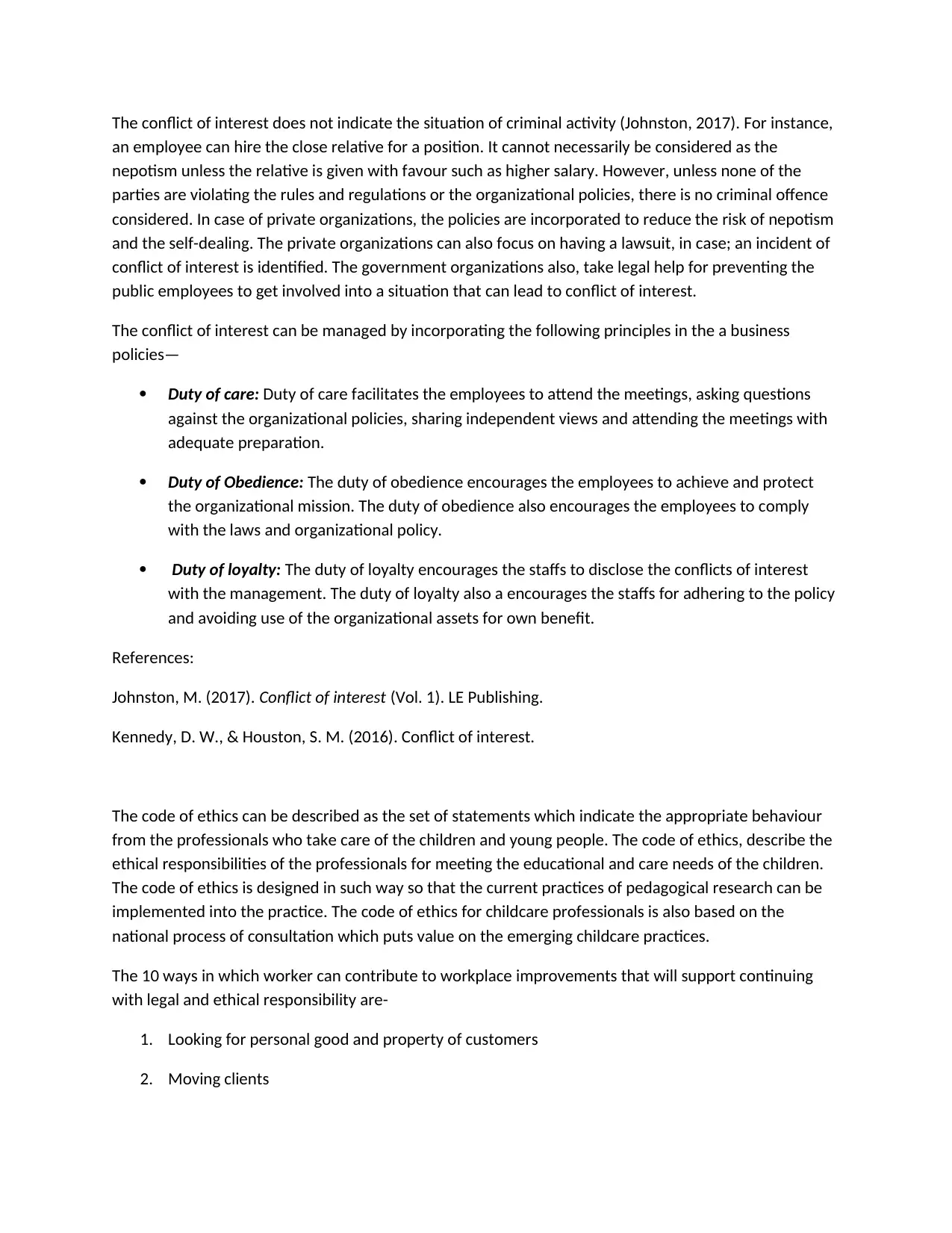
The conflict of interest does not indicate the situation of criminal activity (Johnston, 2017). For instance,
an employee can hire the close relative for a position. It cannot necessarily be considered as the
nepotism unless the relative is given with favour such as higher salary. However, unless none of the
parties are violating the rules and regulations or the organizational policies, there is no criminal offence
considered. In case of private organizations, the policies are incorporated to reduce the risk of nepotism
and the self-dealing. The private organizations can also focus on having a lawsuit, in case; an incident of
conflict of interest is identified. The government organizations also, take legal help for preventing the
public employees to get involved into a situation that can lead to conflict of interest.
The conflict of interest can be managed by incorporating the following principles in the a business
policies—
Duty of care: Duty of care facilitates the employees to attend the meetings, asking questions
against the organizational policies, sharing independent views and attending the meetings with
adequate preparation.
Duty of Obedience: The duty of obedience encourages the employees to achieve and protect
the organizational mission. The duty of obedience also encourages the employees to comply
with the laws and organizational policy.
Duty of loyalty: The duty of loyalty encourages the staffs to disclose the conflicts of interest
with the management. The duty of loyalty also a encourages the staffs for adhering to the policy
and avoiding use of the organizational assets for own benefit.
References:
Johnston, M. (2017). Conflict of interest (Vol. 1). LE Publishing.
Kennedy, D. W., & Houston, S. M. (2016). Conflict of interest.
The code of ethics can be described as the set of statements which indicate the appropriate behaviour
from the professionals who take care of the children and young people. The code of ethics, describe the
ethical responsibilities of the professionals for meeting the educational and care needs of the children.
The code of ethics is designed in such way so that the current practices of pedagogical research can be
implemented into the practice. The code of ethics for childcare professionals is also based on the
national process of consultation which puts value on the emerging childcare practices.
The 10 ways in which worker can contribute to workplace improvements that will support continuing
with legal and ethical responsibility are-
1. Looking for personal good and property of customers
2. Moving clients
an employee can hire the close relative for a position. It cannot necessarily be considered as the
nepotism unless the relative is given with favour such as higher salary. However, unless none of the
parties are violating the rules and regulations or the organizational policies, there is no criminal offence
considered. In case of private organizations, the policies are incorporated to reduce the risk of nepotism
and the self-dealing. The private organizations can also focus on having a lawsuit, in case; an incident of
conflict of interest is identified. The government organizations also, take legal help for preventing the
public employees to get involved into a situation that can lead to conflict of interest.
The conflict of interest can be managed by incorporating the following principles in the a business
policies—
Duty of care: Duty of care facilitates the employees to attend the meetings, asking questions
against the organizational policies, sharing independent views and attending the meetings with
adequate preparation.
Duty of Obedience: The duty of obedience encourages the employees to achieve and protect
the organizational mission. The duty of obedience also encourages the employees to comply
with the laws and organizational policy.
Duty of loyalty: The duty of loyalty encourages the staffs to disclose the conflicts of interest
with the management. The duty of loyalty also a encourages the staffs for adhering to the policy
and avoiding use of the organizational assets for own benefit.
References:
Johnston, M. (2017). Conflict of interest (Vol. 1). LE Publishing.
Kennedy, D. W., & Houston, S. M. (2016). Conflict of interest.
The code of ethics can be described as the set of statements which indicate the appropriate behaviour
from the professionals who take care of the children and young people. The code of ethics, describe the
ethical responsibilities of the professionals for meeting the educational and care needs of the children.
The code of ethics is designed in such way so that the current practices of pedagogical research can be
implemented into the practice. The code of ethics for childcare professionals is also based on the
national process of consultation which puts value on the emerging childcare practices.
The 10 ways in which worker can contribute to workplace improvements that will support continuing
with legal and ethical responsibility are-
1. Looking for personal good and property of customers
2. Moving clients
Paraphrase This Document
Need a fresh take? Get an instant paraphrase of this document with our AI Paraphraser
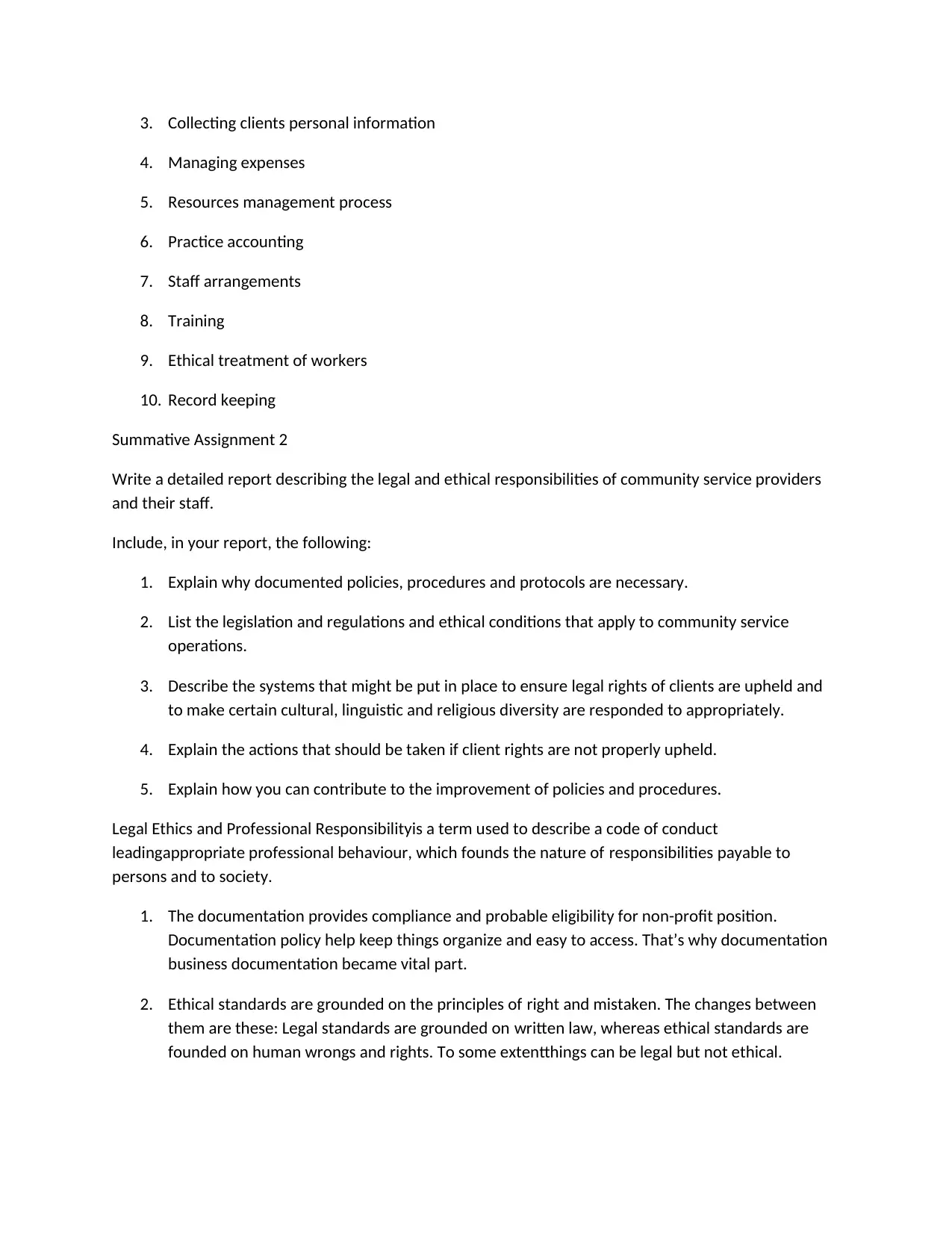
3. Collecting clients personal information
4. Managing expenses
5. Resources management process
6. Practice accounting
7. Staff arrangements
8. Training
9. Ethical treatment of workers
10. Record keeping
Summative Assignment 2
Write a detailed report describing the legal and ethical responsibilities of community service providers
and their staff.
Include, in your report, the following:
1. Explain why documented policies, procedures and protocols are necessary.
2. List the legislation and regulations and ethical conditions that apply to community service
operations.
3. Describe the systems that might be put in place to ensure legal rights of clients are upheld and
to make certain cultural, linguistic and religious diversity are responded to appropriately.
4. Explain the actions that should be taken if client rights are not properly upheld.
5. Explain how you can contribute to the improvement of policies and procedures.
Legal Ethics and Professional Responsibilityis a term used to describe a code of conduct
leadingappropriate professional behaviour, which founds the nature of responsibilities payable to
persons and to society.
1. The documentation provides compliance and probable eligibility for non-profit position.
Documentation policy help keep things organize and easy to access. That’s why documentation
business documentation became vital part.
2. Ethical standards are grounded on the principles of right and mistaken. The changes between
them are these: Legal standards are grounded on written law, whereas ethical standards are
founded on human wrongs and rights. To some extentthings can be legal but not ethical.
4. Managing expenses
5. Resources management process
6. Practice accounting
7. Staff arrangements
8. Training
9. Ethical treatment of workers
10. Record keeping
Summative Assignment 2
Write a detailed report describing the legal and ethical responsibilities of community service providers
and their staff.
Include, in your report, the following:
1. Explain why documented policies, procedures and protocols are necessary.
2. List the legislation and regulations and ethical conditions that apply to community service
operations.
3. Describe the systems that might be put in place to ensure legal rights of clients are upheld and
to make certain cultural, linguistic and religious diversity are responded to appropriately.
4. Explain the actions that should be taken if client rights are not properly upheld.
5. Explain how you can contribute to the improvement of policies and procedures.
Legal Ethics and Professional Responsibilityis a term used to describe a code of conduct
leadingappropriate professional behaviour, which founds the nature of responsibilities payable to
persons and to society.
1. The documentation provides compliance and probable eligibility for non-profit position.
Documentation policy help keep things organize and easy to access. That’s why documentation
business documentation became vital part.
2. Ethical standards are grounded on the principles of right and mistaken. The changes between
them are these: Legal standards are grounded on written law, whereas ethical standards are
founded on human wrongs and rights. To some extentthings can be legal but not ethical.
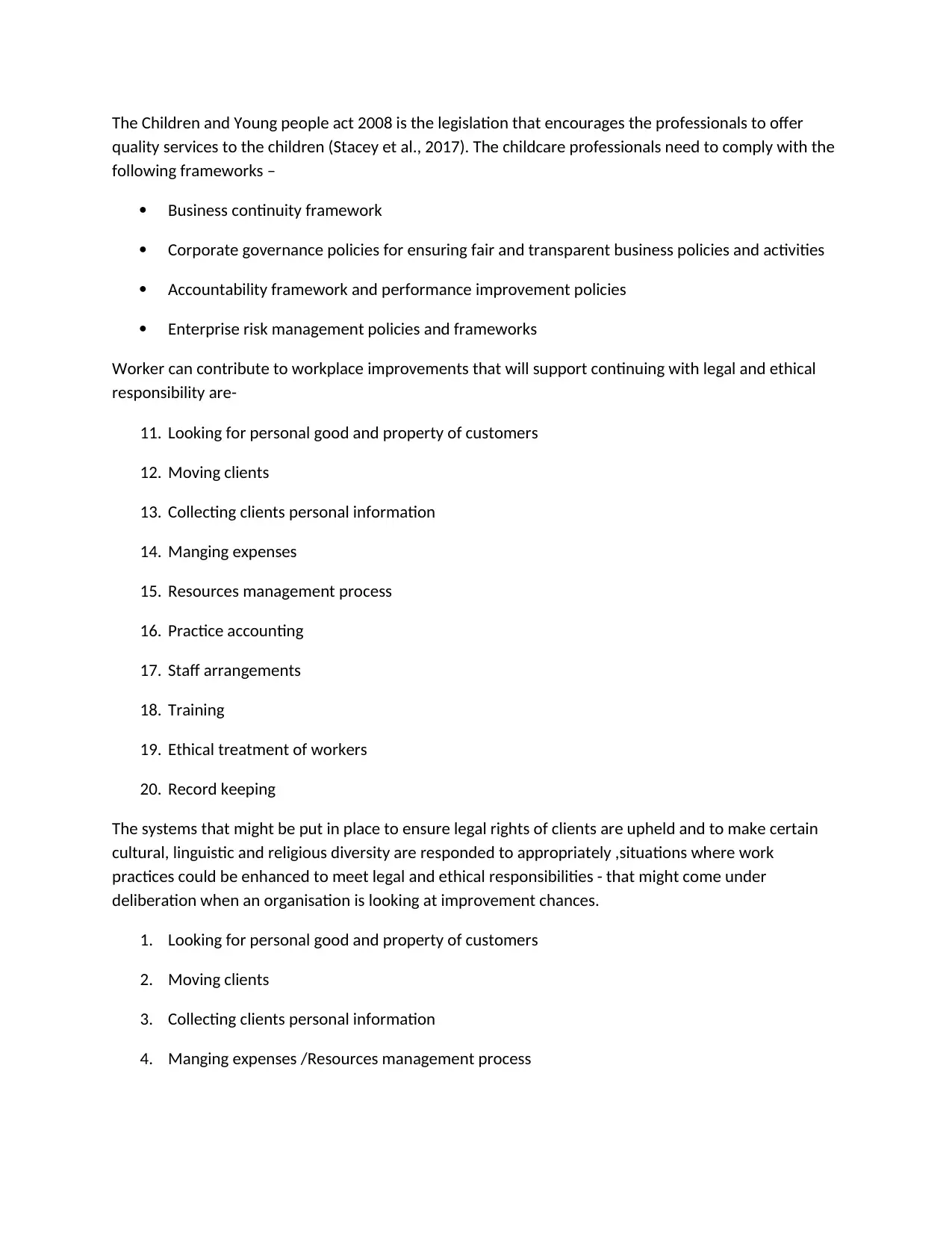
The Children and Young people act 2008 is the legislation that encourages the professionals to offer
quality services to the children (Stacey et al., 2017). The childcare professionals need to comply with the
following frameworks –
Business continuity framework
Corporate governance policies for ensuring fair and transparent business policies and activities
Accountability framework and performance improvement policies
Enterprise risk management policies and frameworks
Worker can contribute to workplace improvements that will support continuing with legal and ethical
responsibility are-
11. Looking for personal good and property of customers
12. Moving clients
13. Collecting clients personal information
14. Manging expenses
15. Resources management process
16. Practice accounting
17. Staff arrangements
18. Training
19. Ethical treatment of workers
20. Record keeping
The systems that might be put in place to ensure legal rights of clients are upheld and to make certain
cultural, linguistic and religious diversity are responded to appropriately ,situations where work
practices could be enhanced to meet legal and ethical responsibilities - that might come under
deliberation when an organisation is looking at improvement chances.
1. Looking for personal good and property of customers
2. Moving clients
3. Collecting clients personal information
4. Manging expenses /Resources management process
quality services to the children (Stacey et al., 2017). The childcare professionals need to comply with the
following frameworks –
Business continuity framework
Corporate governance policies for ensuring fair and transparent business policies and activities
Accountability framework and performance improvement policies
Enterprise risk management policies and frameworks
Worker can contribute to workplace improvements that will support continuing with legal and ethical
responsibility are-
11. Looking for personal good and property of customers
12. Moving clients
13. Collecting clients personal information
14. Manging expenses
15. Resources management process
16. Practice accounting
17. Staff arrangements
18. Training
19. Ethical treatment of workers
20. Record keeping
The systems that might be put in place to ensure legal rights of clients are upheld and to make certain
cultural, linguistic and religious diversity are responded to appropriately ,situations where work
practices could be enhanced to meet legal and ethical responsibilities - that might come under
deliberation when an organisation is looking at improvement chances.
1. Looking for personal good and property of customers
2. Moving clients
3. Collecting clients personal information
4. Manging expenses /Resources management process
⊘ This is a preview!⊘
Do you want full access?
Subscribe today to unlock all pages.

Trusted by 1+ million students worldwide
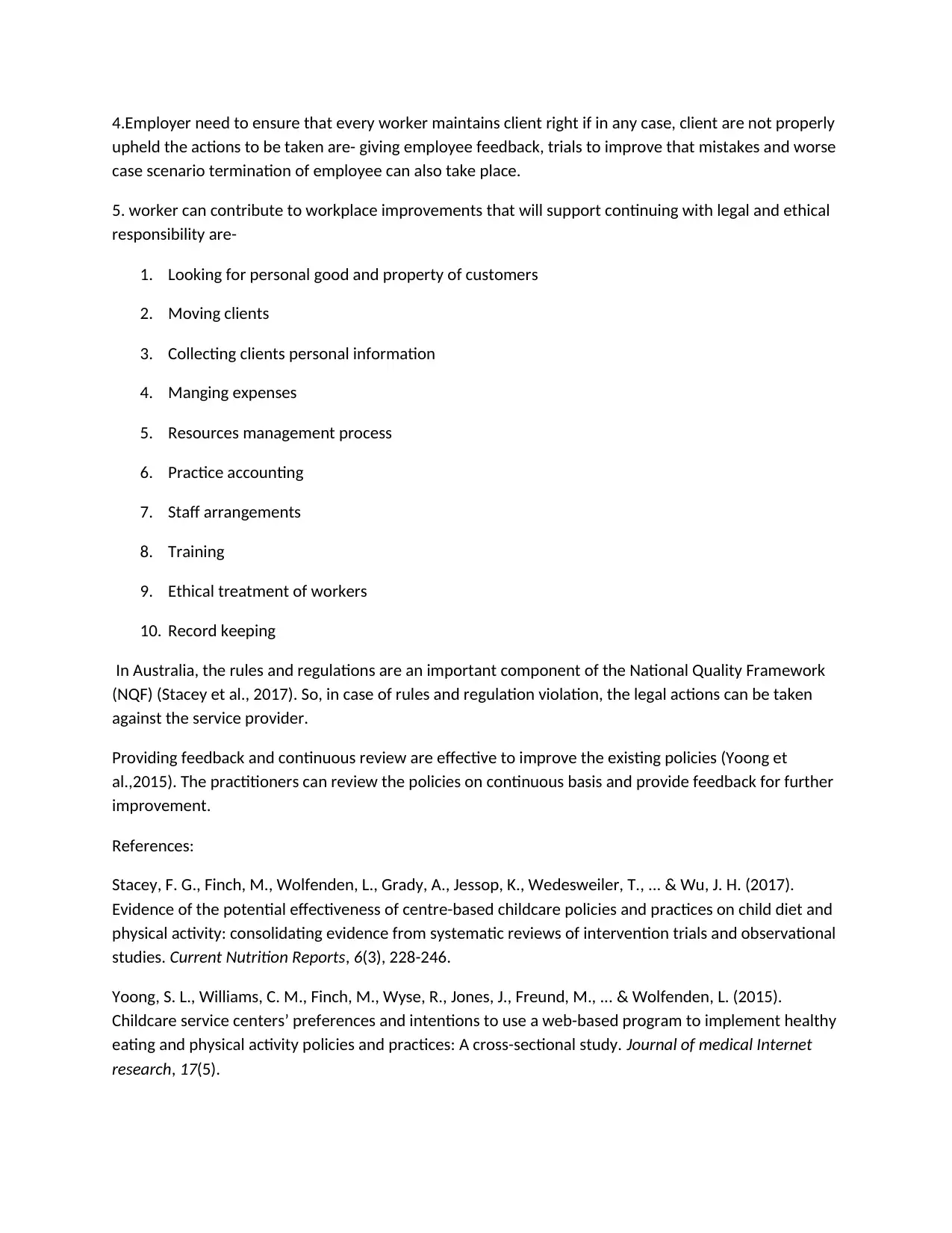
4.Employer need to ensure that every worker maintains client right if in any case, client are not properly
upheld the actions to be taken are- giving employee feedback, trials to improve that mistakes and worse
case scenario termination of employee can also take place.
5. worker can contribute to workplace improvements that will support continuing with legal and ethical
responsibility are-
1. Looking for personal good and property of customers
2. Moving clients
3. Collecting clients personal information
4. Manging expenses
5. Resources management process
6. Practice accounting
7. Staff arrangements
8. Training
9. Ethical treatment of workers
10. Record keeping
In Australia, the rules and regulations are an important component of the National Quality Framework
(NQF) (Stacey et al., 2017). So, in case of rules and regulation violation, the legal actions can be taken
against the service provider.
Providing feedback and continuous review are effective to improve the existing policies (Yoong et
al.,2015). The practitioners can review the policies on continuous basis and provide feedback for further
improvement.
References:
Stacey, F. G., Finch, M., Wolfenden, L., Grady, A., Jessop, K., Wedesweiler, T., ... & Wu, J. H. (2017).
Evidence of the potential effectiveness of centre-based childcare policies and practices on child diet and
physical activity: consolidating evidence from systematic reviews of intervention trials and observational
studies. Current Nutrition Reports, 6(3), 228-246.
Yoong, S. L., Williams, C. M., Finch, M., Wyse, R., Jones, J., Freund, M., ... & Wolfenden, L. (2015).
Childcare service centers’ preferences and intentions to use a web-based program to implement healthy
eating and physical activity policies and practices: A cross-sectional study. Journal of medical Internet
research, 17(5).
upheld the actions to be taken are- giving employee feedback, trials to improve that mistakes and worse
case scenario termination of employee can also take place.
5. worker can contribute to workplace improvements that will support continuing with legal and ethical
responsibility are-
1. Looking for personal good and property of customers
2. Moving clients
3. Collecting clients personal information
4. Manging expenses
5. Resources management process
6. Practice accounting
7. Staff arrangements
8. Training
9. Ethical treatment of workers
10. Record keeping
In Australia, the rules and regulations are an important component of the National Quality Framework
(NQF) (Stacey et al., 2017). So, in case of rules and regulation violation, the legal actions can be taken
against the service provider.
Providing feedback and continuous review are effective to improve the existing policies (Yoong et
al.,2015). The practitioners can review the policies on continuous basis and provide feedback for further
improvement.
References:
Stacey, F. G., Finch, M., Wolfenden, L., Grady, A., Jessop, K., Wedesweiler, T., ... & Wu, J. H. (2017).
Evidence of the potential effectiveness of centre-based childcare policies and practices on child diet and
physical activity: consolidating evidence from systematic reviews of intervention trials and observational
studies. Current Nutrition Reports, 6(3), 228-246.
Yoong, S. L., Williams, C. M., Finch, M., Wyse, R., Jones, J., Freund, M., ... & Wolfenden, L. (2015).
Childcare service centers’ preferences and intentions to use a web-based program to implement healthy
eating and physical activity policies and practices: A cross-sectional study. Journal of medical Internet
research, 17(5).
Paraphrase This Document
Need a fresh take? Get an instant paraphrase of this document with our AI Paraphraser
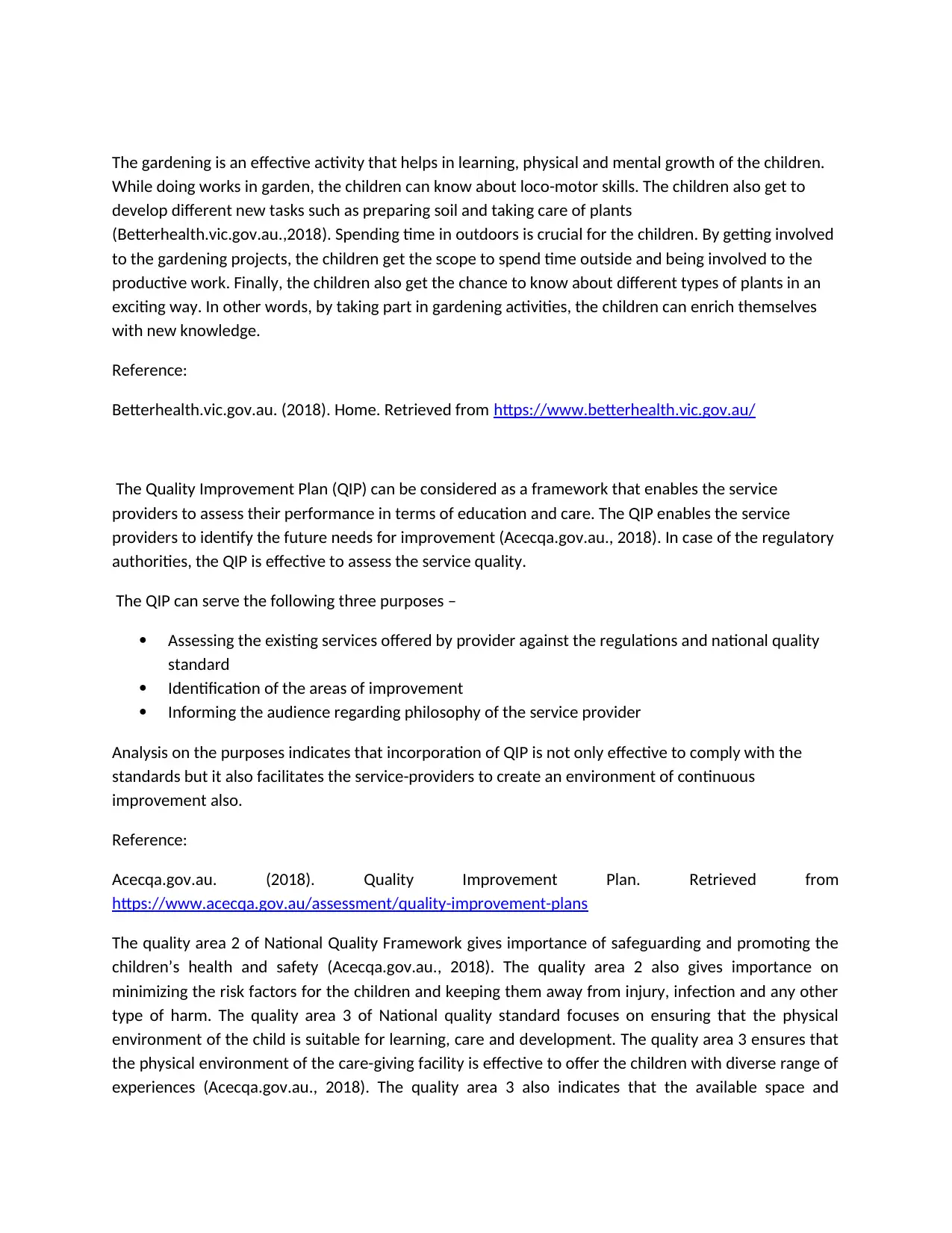
The gardening is an effective activity that helps in learning, physical and mental growth of the children.
While doing works in garden, the children can know about loco-motor skills. The children also get to
develop different new tasks such as preparing soil and taking care of plants
(Betterhealth.vic.gov.au.,2018). Spending time in outdoors is crucial for the children. By getting involved
to the gardening projects, the children get the scope to spend time outside and being involved to the
productive work. Finally, the children also get the chance to know about different types of plants in an
exciting way. In other words, by taking part in gardening activities, the children can enrich themselves
with new knowledge.
Reference:
Betterhealth.vic.gov.au. (2018). Home. Retrieved from https://www.betterhealth.vic.gov.au/
The Quality Improvement Plan (QIP) can be considered as a framework that enables the service
providers to assess their performance in terms of education and care. The QIP enables the service
providers to identify the future needs for improvement (Acecqa.gov.au., 2018). In case of the regulatory
authorities, the QIP is effective to assess the service quality.
The QIP can serve the following three purposes –
Assessing the existing services offered by provider against the regulations and national quality
standard
Identification of the areas of improvement
Informing the audience regarding philosophy of the service provider
Analysis on the purposes indicates that incorporation of QIP is not only effective to comply with the
standards but it also facilitates the service-providers to create an environment of continuous
improvement also.
Reference:
Acecqa.gov.au. (2018). Quality Improvement Plan. Retrieved from
https://www.acecqa.gov.au/assessment/quality-improvement-plans
The quality area 2 of National Quality Framework gives importance of safeguarding and promoting the
children’s health and safety (Acecqa.gov.au., 2018). The quality area 2 also gives importance on
minimizing the risk factors for the children and keeping them away from injury, infection and any other
type of harm. The quality area 3 of National quality standard focuses on ensuring that the physical
environment of the child is suitable for learning, care and development. The quality area 3 ensures that
the physical environment of the care-giving facility is effective to offer the children with diverse range of
experiences (Acecqa.gov.au., 2018). The quality area 3 also indicates that the available space and
While doing works in garden, the children can know about loco-motor skills. The children also get to
develop different new tasks such as preparing soil and taking care of plants
(Betterhealth.vic.gov.au.,2018). Spending time in outdoors is crucial for the children. By getting involved
to the gardening projects, the children get the scope to spend time outside and being involved to the
productive work. Finally, the children also get the chance to know about different types of plants in an
exciting way. In other words, by taking part in gardening activities, the children can enrich themselves
with new knowledge.
Reference:
Betterhealth.vic.gov.au. (2018). Home. Retrieved from https://www.betterhealth.vic.gov.au/
The Quality Improvement Plan (QIP) can be considered as a framework that enables the service
providers to assess their performance in terms of education and care. The QIP enables the service
providers to identify the future needs for improvement (Acecqa.gov.au., 2018). In case of the regulatory
authorities, the QIP is effective to assess the service quality.
The QIP can serve the following three purposes –
Assessing the existing services offered by provider against the regulations and national quality
standard
Identification of the areas of improvement
Informing the audience regarding philosophy of the service provider
Analysis on the purposes indicates that incorporation of QIP is not only effective to comply with the
standards but it also facilitates the service-providers to create an environment of continuous
improvement also.
Reference:
Acecqa.gov.au. (2018). Quality Improvement Plan. Retrieved from
https://www.acecqa.gov.au/assessment/quality-improvement-plans
The quality area 2 of National Quality Framework gives importance of safeguarding and promoting the
children’s health and safety (Acecqa.gov.au., 2018). The quality area 2 also gives importance on
minimizing the risk factors for the children and keeping them away from injury, infection and any other
type of harm. The quality area 3 of National quality standard focuses on ensuring that the physical
environment of the child is suitable for learning, care and development. The quality area 3 ensures that
the physical environment of the care-giving facility is effective to offer the children with diverse range of
experiences (Acecqa.gov.au., 2018). The quality area 3 also indicates that the available space and
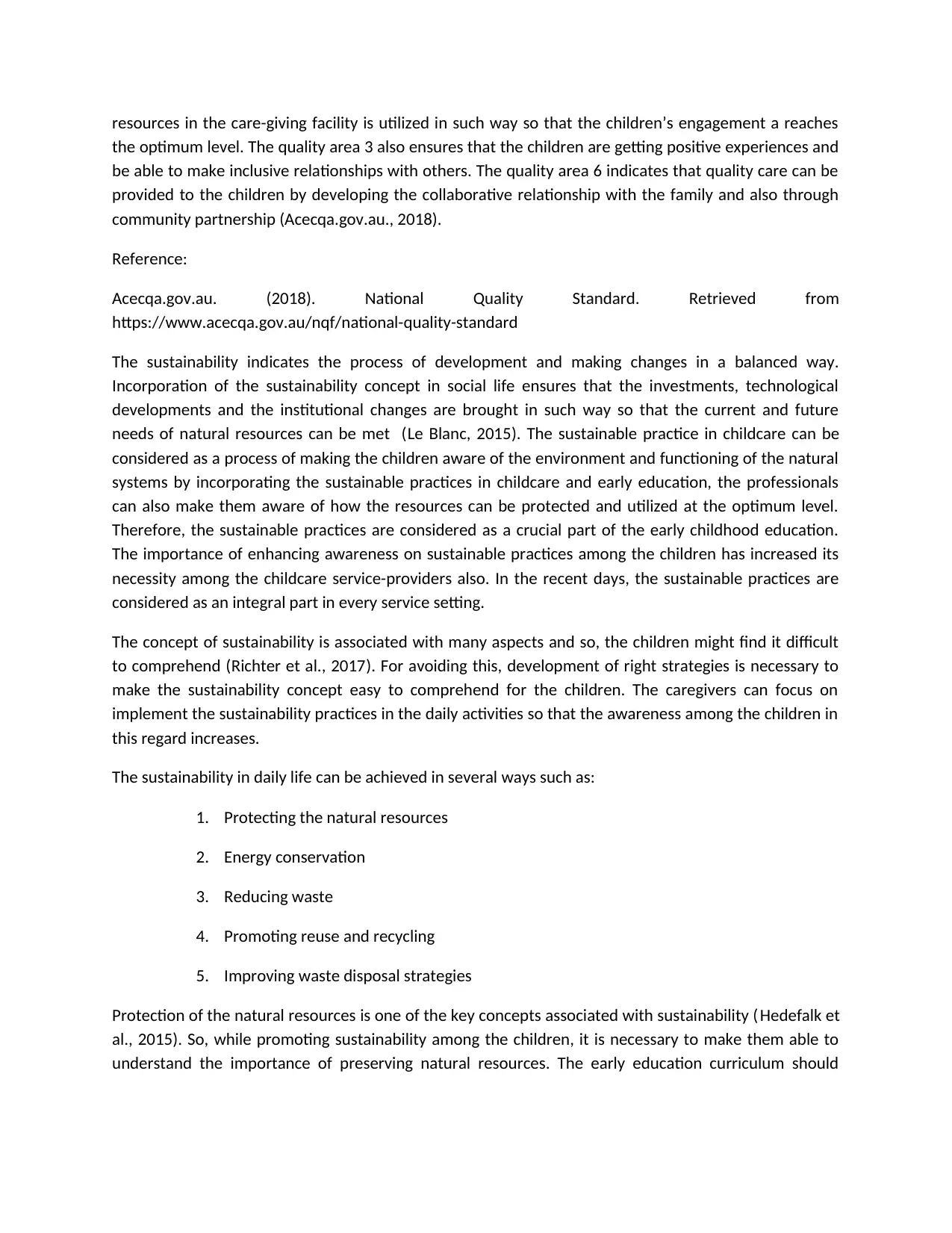
resources in the care-giving facility is utilized in such way so that the children’s engagement a reaches
the optimum level. The quality area 3 also ensures that the children are getting positive experiences and
be able to make inclusive relationships with others. The quality area 6 indicates that quality care can be
provided to the children by developing the collaborative relationship with the family and also through
community partnership (Acecqa.gov.au., 2018).
Reference:
Acecqa.gov.au. (2018). National Quality Standard. Retrieved from
https://www.acecqa.gov.au/nqf/national-quality-standard
The sustainability indicates the process of development and making changes in a balanced way.
Incorporation of the sustainability concept in social life ensures that the investments, technological
developments and the institutional changes are brought in such way so that the current and future
needs of natural resources can be met (Le Blanc, 2015). The sustainable practice in childcare can be
considered as a process of making the children aware of the environment and functioning of the natural
systems by incorporating the sustainable practices in childcare and early education, the professionals
can also make them aware of how the resources can be protected and utilized at the optimum level.
Therefore, the sustainable practices are considered as a crucial part of the early childhood education.
The importance of enhancing awareness on sustainable practices among the children has increased its
necessity among the childcare service-providers also. In the recent days, the sustainable practices are
considered as an integral part in every service setting.
The concept of sustainability is associated with many aspects and so, the children might find it difficult
to comprehend (Richter et al., 2017). For avoiding this, development of right strategies is necessary to
make the sustainability concept easy to comprehend for the children. The caregivers can focus on
implement the sustainability practices in the daily activities so that the awareness among the children in
this regard increases.
The sustainability in daily life can be achieved in several ways such as:
1. Protecting the natural resources
2. Energy conservation
3. Reducing waste
4. Promoting reuse and recycling
5. Improving waste disposal strategies
Protection of the natural resources is one of the key concepts associated with sustainability ( Hedefalk et
al., 2015). So, while promoting sustainability among the children, it is necessary to make them able to
understand the importance of preserving natural resources. The early education curriculum should
the optimum level. The quality area 3 also ensures that the children are getting positive experiences and
be able to make inclusive relationships with others. The quality area 6 indicates that quality care can be
provided to the children by developing the collaborative relationship with the family and also through
community partnership (Acecqa.gov.au., 2018).
Reference:
Acecqa.gov.au. (2018). National Quality Standard. Retrieved from
https://www.acecqa.gov.au/nqf/national-quality-standard
The sustainability indicates the process of development and making changes in a balanced way.
Incorporation of the sustainability concept in social life ensures that the investments, technological
developments and the institutional changes are brought in such way so that the current and future
needs of natural resources can be met (Le Blanc, 2015). The sustainable practice in childcare can be
considered as a process of making the children aware of the environment and functioning of the natural
systems by incorporating the sustainable practices in childcare and early education, the professionals
can also make them aware of how the resources can be protected and utilized at the optimum level.
Therefore, the sustainable practices are considered as a crucial part of the early childhood education.
The importance of enhancing awareness on sustainable practices among the children has increased its
necessity among the childcare service-providers also. In the recent days, the sustainable practices are
considered as an integral part in every service setting.
The concept of sustainability is associated with many aspects and so, the children might find it difficult
to comprehend (Richter et al., 2017). For avoiding this, development of right strategies is necessary to
make the sustainability concept easy to comprehend for the children. The caregivers can focus on
implement the sustainability practices in the daily activities so that the awareness among the children in
this regard increases.
The sustainability in daily life can be achieved in several ways such as:
1. Protecting the natural resources
2. Energy conservation
3. Reducing waste
4. Promoting reuse and recycling
5. Improving waste disposal strategies
Protection of the natural resources is one of the key concepts associated with sustainability ( Hedefalk et
al., 2015). So, while promoting sustainability among the children, it is necessary to make them able to
understand the importance of preserving natural resources. The early education curriculum should
⊘ This is a preview!⊘
Do you want full access?
Subscribe today to unlock all pages.

Trusted by 1+ million students worldwide
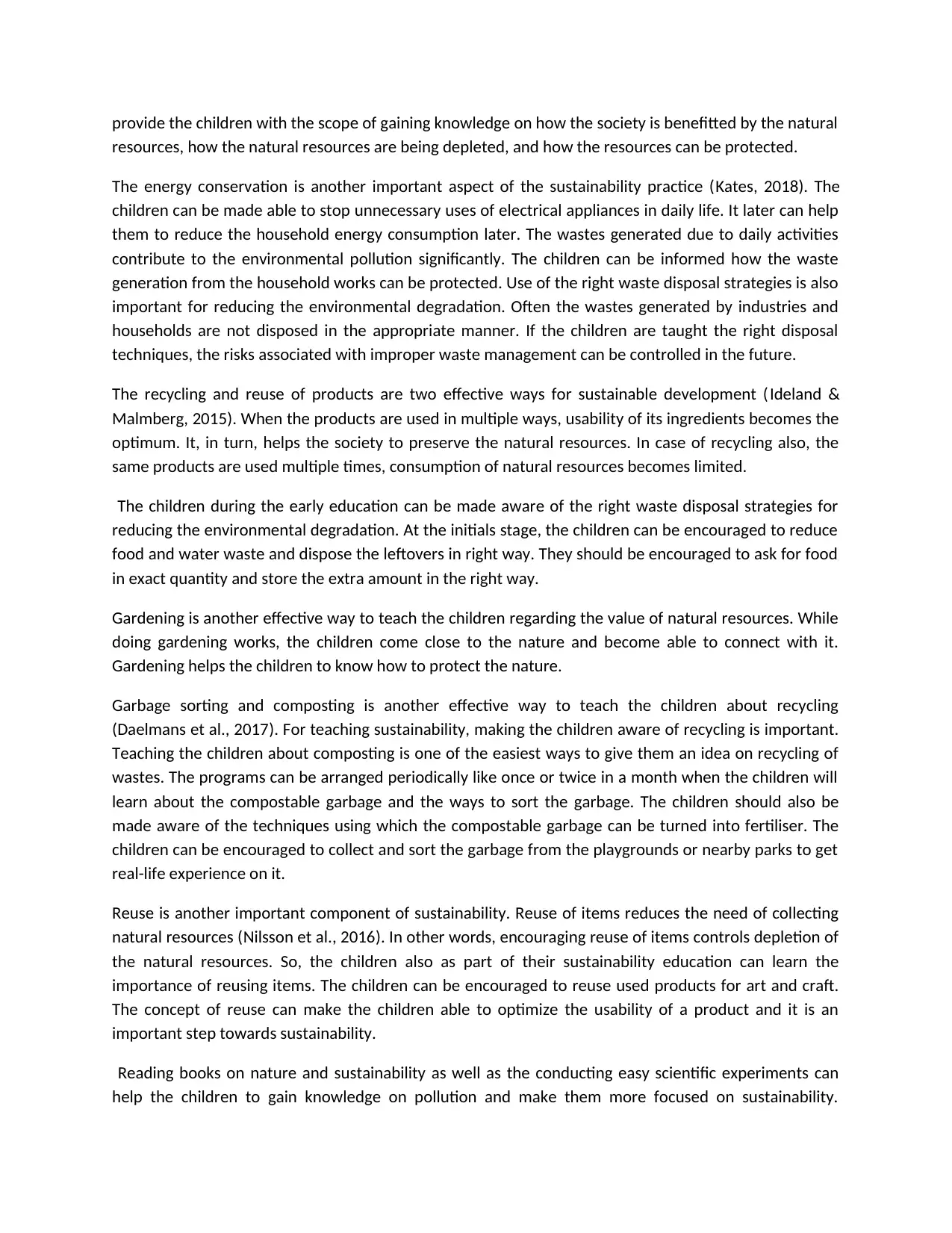
provide the children with the scope of gaining knowledge on how the society is benefitted by the natural
resources, how the natural resources are being depleted, and how the resources can be protected.
The energy conservation is another important aspect of the sustainability practice (Kates, 2018). The
children can be made able to stop unnecessary uses of electrical appliances in daily life. It later can help
them to reduce the household energy consumption later. The wastes generated due to daily activities
contribute to the environmental pollution significantly. The children can be informed how the waste
generation from the household works can be protected. Use of the right waste disposal strategies is also
important for reducing the environmental degradation. Often the wastes generated by industries and
households are not disposed in the appropriate manner. If the children are taught the right disposal
techniques, the risks associated with improper waste management can be controlled in the future.
The recycling and reuse of products are two effective ways for sustainable development (Ideland &
Malmberg, 2015). When the products are used in multiple ways, usability of its ingredients becomes the
optimum. It, in turn, helps the society to preserve the natural resources. In case of recycling also, the
same products are used multiple times, consumption of natural resources becomes limited.
The children during the early education can be made aware of the right waste disposal strategies for
reducing the environmental degradation. At the initials stage, the children can be encouraged to reduce
food and water waste and dispose the leftovers in right way. They should be encouraged to ask for food
in exact quantity and store the extra amount in the right way.
Gardening is another effective way to teach the children regarding the value of natural resources. While
doing gardening works, the children come close to the nature and become able to connect with it.
Gardening helps the children to know how to protect the nature.
Garbage sorting and composting is another effective way to teach the children about recycling
(Daelmans et al., 2017). For teaching sustainability, making the children aware of recycling is important.
Teaching the children about composting is one of the easiest ways to give them an idea on recycling of
wastes. The programs can be arranged periodically like once or twice in a month when the children will
learn about the compostable garbage and the ways to sort the garbage. The children should also be
made aware of the techniques using which the compostable garbage can be turned into fertiliser. The
children can be encouraged to collect and sort the garbage from the playgrounds or nearby parks to get
real-life experience on it.
Reuse is another important component of sustainability. Reuse of items reduces the need of collecting
natural resources (Nilsson et al., 2016). In other words, encouraging reuse of items controls depletion of
the natural resources. So, the children also as part of their sustainability education can learn the
importance of reusing items. The children can be encouraged to reuse used products for art and craft.
The concept of reuse can make the children able to optimize the usability of a product and it is an
important step towards sustainability.
Reading books on nature and sustainability as well as the conducting easy scientific experiments can
help the children to gain knowledge on pollution and make them more focused on sustainability.
resources, how the natural resources are being depleted, and how the resources can be protected.
The energy conservation is another important aspect of the sustainability practice (Kates, 2018). The
children can be made able to stop unnecessary uses of electrical appliances in daily life. It later can help
them to reduce the household energy consumption later. The wastes generated due to daily activities
contribute to the environmental pollution significantly. The children can be informed how the waste
generation from the household works can be protected. Use of the right waste disposal strategies is also
important for reducing the environmental degradation. Often the wastes generated by industries and
households are not disposed in the appropriate manner. If the children are taught the right disposal
techniques, the risks associated with improper waste management can be controlled in the future.
The recycling and reuse of products are two effective ways for sustainable development (Ideland &
Malmberg, 2015). When the products are used in multiple ways, usability of its ingredients becomes the
optimum. It, in turn, helps the society to preserve the natural resources. In case of recycling also, the
same products are used multiple times, consumption of natural resources becomes limited.
The children during the early education can be made aware of the right waste disposal strategies for
reducing the environmental degradation. At the initials stage, the children can be encouraged to reduce
food and water waste and dispose the leftovers in right way. They should be encouraged to ask for food
in exact quantity and store the extra amount in the right way.
Gardening is another effective way to teach the children regarding the value of natural resources. While
doing gardening works, the children come close to the nature and become able to connect with it.
Gardening helps the children to know how to protect the nature.
Garbage sorting and composting is another effective way to teach the children about recycling
(Daelmans et al., 2017). For teaching sustainability, making the children aware of recycling is important.
Teaching the children about composting is one of the easiest ways to give them an idea on recycling of
wastes. The programs can be arranged periodically like once or twice in a month when the children will
learn about the compostable garbage and the ways to sort the garbage. The children should also be
made aware of the techniques using which the compostable garbage can be turned into fertiliser. The
children can be encouraged to collect and sort the garbage from the playgrounds or nearby parks to get
real-life experience on it.
Reuse is another important component of sustainability. Reuse of items reduces the need of collecting
natural resources (Nilsson et al., 2016). In other words, encouraging reuse of items controls depletion of
the natural resources. So, the children also as part of their sustainability education can learn the
importance of reusing items. The children can be encouraged to reuse used products for art and craft.
The concept of reuse can make the children able to optimize the usability of a product and it is an
important step towards sustainability.
Reading books on nature and sustainability as well as the conducting easy scientific experiments can
help the children to gain knowledge on pollution and make them more focused on sustainability.
Paraphrase This Document
Need a fresh take? Get an instant paraphrase of this document with our AI Paraphraser
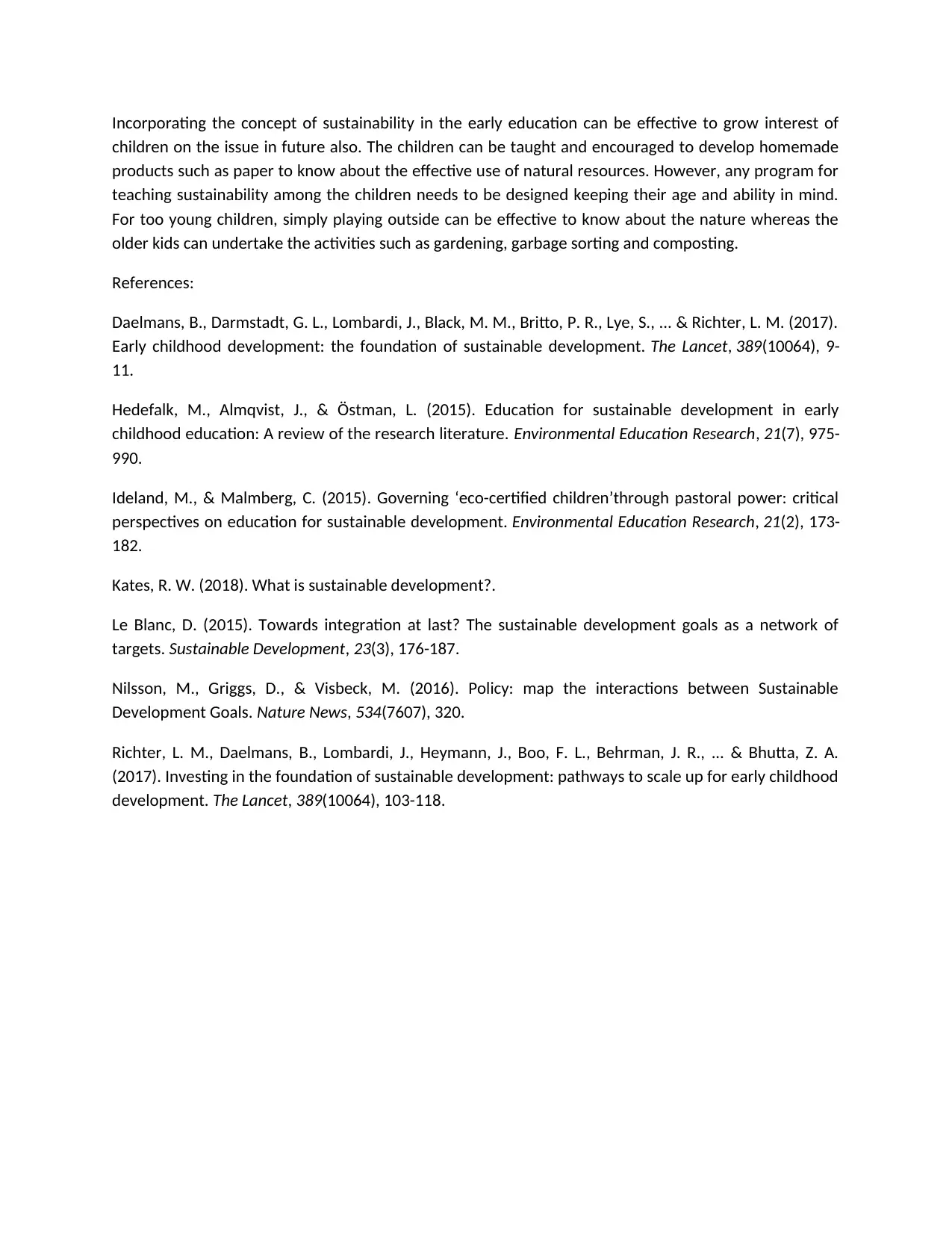
Incorporating the concept of sustainability in the early education can be effective to grow interest of
children on the issue in future also. The children can be taught and encouraged to develop homemade
products such as paper to know about the effective use of natural resources. However, any program for
teaching sustainability among the children needs to be designed keeping their age and ability in mind.
For too young children, simply playing outside can be effective to know about the nature whereas the
older kids can undertake the activities such as gardening, garbage sorting and composting.
References:
Daelmans, B., Darmstadt, G. L., Lombardi, J., Black, M. M., Britto, P. R., Lye, S., ... & Richter, L. M. (2017).
Early childhood development: the foundation of sustainable development. The Lancet, 389(10064), 9-
11.
Hedefalk, M., Almqvist, J., & Östman, L. (2015). Education for sustainable development in early
childhood education: A review of the research literature. Environmental Education Research, 21(7), 975-
990.
Ideland, M., & Malmberg, C. (2015). Governing ‘eco-certified children’through pastoral power: critical
perspectives on education for sustainable development. Environmental Education Research, 21(2), 173-
182.
Kates, R. W. (2018). What is sustainable development?.
Le Blanc, D. (2015). Towards integration at last? The sustainable development goals as a network of
targets. Sustainable Development, 23(3), 176-187.
Nilsson, M., Griggs, D., & Visbeck, M. (2016). Policy: map the interactions between Sustainable
Development Goals. Nature News, 534(7607), 320.
Richter, L. M., Daelmans, B., Lombardi, J., Heymann, J., Boo, F. L., Behrman, J. R., ... & Bhutta, Z. A.
(2017). Investing in the foundation of sustainable development: pathways to scale up for early childhood
development. The Lancet, 389(10064), 103-118.
children on the issue in future also. The children can be taught and encouraged to develop homemade
products such as paper to know about the effective use of natural resources. However, any program for
teaching sustainability among the children needs to be designed keeping their age and ability in mind.
For too young children, simply playing outside can be effective to know about the nature whereas the
older kids can undertake the activities such as gardening, garbage sorting and composting.
References:
Daelmans, B., Darmstadt, G. L., Lombardi, J., Black, M. M., Britto, P. R., Lye, S., ... & Richter, L. M. (2017).
Early childhood development: the foundation of sustainable development. The Lancet, 389(10064), 9-
11.
Hedefalk, M., Almqvist, J., & Östman, L. (2015). Education for sustainable development in early
childhood education: A review of the research literature. Environmental Education Research, 21(7), 975-
990.
Ideland, M., & Malmberg, C. (2015). Governing ‘eco-certified children’through pastoral power: critical
perspectives on education for sustainable development. Environmental Education Research, 21(2), 173-
182.
Kates, R. W. (2018). What is sustainable development?.
Le Blanc, D. (2015). Towards integration at last? The sustainable development goals as a network of
targets. Sustainable Development, 23(3), 176-187.
Nilsson, M., Griggs, D., & Visbeck, M. (2016). Policy: map the interactions between Sustainable
Development Goals. Nature News, 534(7607), 320.
Richter, L. M., Daelmans, B., Lombardi, J., Heymann, J., Boo, F. L., Behrman, J. R., ... & Bhutta, Z. A.
(2017). Investing in the foundation of sustainable development: pathways to scale up for early childhood
development. The Lancet, 389(10064), 103-118.
1 out of 11
Your All-in-One AI-Powered Toolkit for Academic Success.
+13062052269
info@desklib.com
Available 24*7 on WhatsApp / Email
![[object Object]](/_next/static/media/star-bottom.7253800d.svg)
Unlock your academic potential
Copyright © 2020–2025 A2Z Services. All Rights Reserved. Developed and managed by ZUCOL.